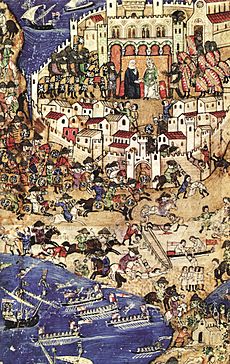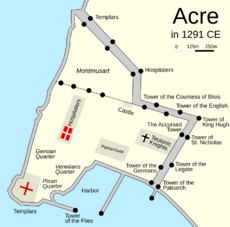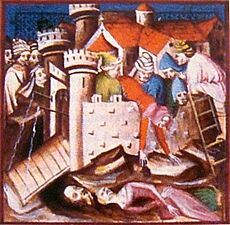Siege of Acre (1291) facts for kids
Quick facts for kids Siege of Acre (1291) |
|||||||||
|---|---|---|---|---|---|---|---|---|---|
| Part of the Crusades | |||||||||
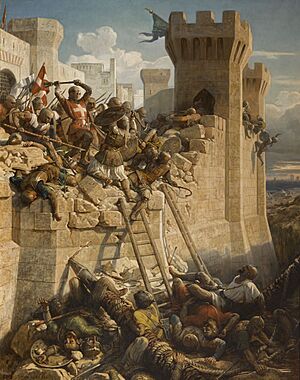 Matthieu de Clermont défend Ptolémaïs en 1291, by Dominique Papety (1815–49) at Salles des Croisades in Versailles |
|||||||||
|
|||||||||
| Belligerents | |||||||||
|
|
||||||||
| Commanders and leaders | |||||||||
|
|
||||||||
| Strength | |||||||||
| Unknown |
Acre: 15,000 Cyprus: 700 |
||||||||
| Casualties and losses | |||||||||
| Unknown | 10,000+ |
||||||||
The Siege of Acre (also known as the Fall of Acre) happened in 1291. It was a major battle where the Crusaders lost control of the city of Acre to the Mamluks. This event is seen as one of the most important battles of that time.
Even though the Crusades continued for a few more centuries, capturing Acre meant the end of major Crusades to the Levant (the eastern Mediterranean region). When Acre fell, the Crusaders lost their last big stronghold in the Kingdom of Jerusalem. They still had a fortress in Tartus and tried some raids, but after losing the island of Ruad in 1302, the Crusaders no longer controlled any part of the Holy Land.
Contents
Why did the Siege of Acre happen?
The Crusader Kingdom's Challenges
In 1187, a leader named Saladin took over much of the Kingdom of Jerusalem. This included Acre and Jerusalem, after winning the Battle of Hattin. To get these lands back, the Third Crusade was launched. The Crusaders then besieged and recaptured Acre in 1191. Acre became the capital of the Kingdom of Jerusalem. Important religious groups like the Knights Templar and Hospitaller set up their main offices there.
The Rise of the Mamluks
In 1250, the Mamluk Sultanate formed in Egypt. They were a strong new enemy, even tougher than the earlier Ayyubids. The Mamluks had powerful cavalry, which could match the Crusader knights. They were also much more against the Crusaders.
At first, the Crusaders tried to stay neutral with the Mamluks. In 1260, the leaders in Acre even let the Mamluks pass through their land. This allowed the Mamluks to fight the Mongols. The Mamluks won a key battle against the Mongols, called the Battle of Ain Jalut. This was a rare moment of peace between the Christians and Mamluks.
However, soon after, in 1261, the Mamluk leader Sultan Baibars began attacking the Crusaders. Baibars captured important Crusader cities like Caesarea, Haifa, and Arsuf in 1265. He then took all the major Crusader lands in Galilee the next year. In 1268, he captured Antioch.
European Support Fades
European countries sent small Crusader groups to help. These included the Eighth Crusade by Louis IX of France in 1270 and the Ninth Crusade by Prince Edward (who later became King Edward I) in 1271–1272. But these groups were too small and didn't stay long enough to make a real difference.
No big Crusades came to help. Pope Gregory X tried to get support for another large Crusade, but it was hard. People were less excited about Crusades. This was partly because earlier Popes had used Crusades for other reasons in Europe.
The Crusader states kept getting weaker from constant attacks and internal problems. In 1276, King Hugh III moved his court to Cyprus. The Mamluk Sultan Al-Mansur Qalawun captured Lattakia in 1278. He then conquered the County of Tripoli in 1289. Qalawun had signed a ten-year peace agreement with the Kingdom of Jerusalem in 1284.
After Tripoli fell, King Henry II sent Jean de Grailly to warn European kings. Pope Nicholas IV also wrote letters asking for help. But other conflicts in Europe, like the War of the Sicilian Vespers, were more important to them. King Edward I of England was too busy with problems at home.
Years of talks between Europeans and the Mongols also failed to create a strong alliance.
A Reason for Attack
An Arab story says that a relationship between a rich young woman in Acre and a Muslim man was discovered.
The Crusaders worried that Sultan Qalawun would use this as an excuse to restart the war. They asked the Pope for more soldiers. Some sources say 25 Venetian ships with 1600 men were sent. Others mention 20 ships with peasants and unemployed people from Italy. These groups were joined by five ships from King James II of Aragon.
These Italian soldiers were not well-trained and didn't get regular pay. They robbed both Muslims and Christians around Acre in August 1290. Sultan Qalawun demanded that the Christian attackers be handed over. The Crusader leaders, including Guillaume de Beaujeu, the leader of the Knights Templar, discussed this. They refused to hand over the attackers, saying the murdered Muslims were to blame.
The Siege of Acre Begins
Preparing for Battle
Sultan Qalawun ended the peace agreement with Acre. The Mamluks started gathering their army by October 1290. Qalawun died in December, and his son, Al-Ashraf Khalil, became the new Sultan. Guillaume de Beaujeu received a message from Khalil. It said Khalil planned to attack Acre and would not make peace.
Still, the Crusaders sent a peace group to Cairo. But the group was put in prison. Khalil left Cairo in March 1291 to attack Acre.
The Mamluk army was much larger than the Crusaders' forces. Khalil called for soldiers from all over Syria to join his Egyptian army. These included groups from Damascus, Hama, Tripoli, and al-Karak. Many soldiers were volunteers. The army also had many large war machines, like catapults. Hama sent a huge catapult called "The Victorious." Another big one was "The Furious." There were also smaller machines called "the Black Bulls."
Famous historians like Baybars al-Dewadar and Abulfeda were part of the Mamluk army.
The Crusaders' calls for help did not bring much success. England sent a few knights, like Otto de Grandson. The most important help came from King Henry II of Cyprus. He strengthened the walls and sent 700 soldiers led by his brother Amalric, Lord of Tyre. The leader of the Teutonic Order, Burchard von Schwanden, suddenly quit and left Acre. He was replaced by Konrad von Feuchtwangen. The only large group to leave Acre were the Genoese, who made their own peace deal with Khalil. Many women and children were sent away from Acre to Cyprus in March.
Acre was protected by two walls, an inner and an outer one. It had twelve towers built by European kings and rich pilgrims.
First Days of the Siege
Sultan Khalil and the Egyptian army arrived at Acre on April 6, 1291. The Syrian armies arrived two days later with their siege machines. The Mamluk camp stretched for about two kilometers, from one side of the coast to the other. It was about two kilometers from the city walls.
For the first eight days, there was little fighting. The Mamluks set up their camp. From day nine to eleven, the Mamluks moved forward with barricades and screens. They reached the ditch in front of the outer wall. Fast-firing siege machines were brought up. The Mamluks began digging tunnels under the walls and bombarding them with stones. Acre's gates stayed open for soldiers to rush out and attack, but they were heavily guarded.
The Crusaders launched several attacks on the Mamluk camp. An attack from the sea on the Hama soldiers was successful, but the Crusaders lost many men. In another raid, three hundred Templar knights, led by Jean I de Grailly and Otto de Grandson, rode out at night. They tried to destroy the Hama artillery with Greek fire. They didn't destroy the artillery, but they fought over 1000 Mamluks and returned with captured supplies. Sultan Khalil punished some of his officers for this. Overall, Crusader attacks failed to stop the Mamluks from preparing their main assault.
King Henry II of Cyprus arrived on May 4 with 700 more soldiers on 40 ships. The king's arrival made everyone feel better for a short time. But after looking at the city, Henry II decided to try to make a deal. The Crusaders thought they could pay money to get a truce. On May 17, two knights were sent to talk with the Sultan. The talks failed. The Crusaders refused to surrender. They asked Khalil to stop the siege for the sake of the people in the city. Khalil still wanted to conquer the city. He offered to let the defenders leave with their lives and property, but this was rejected. During the meeting, a Crusader stone from a catapult landed near the Sultan's tent. The Sultan became very angry and ordered a full attack for the next day. The messengers returned to the city safely.
The Mamluk attack was planned for weeks. By May 18, many towers and parts of the wall had fallen due to tunnels dug underneath them. Parts of the ditch were filled in. The fall of the King's Tower made the defenders lose hope. The evacuation of women and children sped up.
The City is Stormed
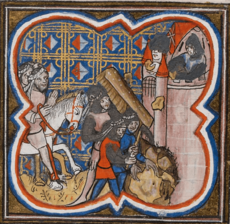
The Mamluk army gathered before sunrise on May 18. They attacked along the entire wall, with trumpets and drums playing loudly. The Mamluks poured through the broken parts of the walls. By 9 AM, it was clear what the outcome would be. The Mamluks captured the Accursed Tower on the inner wall. This forced the Crusaders to fall back to the Gate of St. Anthony. Guillaume de Beaujeu was badly wounded defending this gate and died. On the Montmusard walls, the Lazarists stayed to fight. The Templars and Hospitallers tried to retake the Accursed Tower but failed. This movement allowed the Hama soldiers to break through the Montmusard walls and kill the Lazarists. The Mamluks broke through more places as the Crusaders left the walls.
The Mamluks pushed into the city, stealing and killing everyone they found. The Crusaders' organized defense fell apart. The retreat to the harbor and the ships was very messy. Rich refugees offered huge amounts of money for a safe trip. King Henry II and Jean de Villiers, the leader of the Knights Hospitaller, were among those who escaped. The bad weather made the escape even harder.
Acre Falls Completely
By the night of May 18, Acre was in Mamluk hands. Only the Templar fortress by the sea, at the western tip of the city, remained. This fortress had four towers. Inside were the remaining Templar, Hospitaller, and Teutonic Knights, along with thousands of civilians. The fortress held out for ten more days. During this time, Matthew of Clermont, a Hospitaller leader, was killed. Templar Thibaud Gaudin and a few others left the fortress secretly. They took the Templar treasury with them to Sidon.
On May 20, the Templars in the tower, led by Peter de Severy, asked for mercy. Sultan Khalil agreed to let the women and children leave the city. The gates were opened, and 400 Mamluk horsemen entered the complex. But they immediately attacked the women and children. Peter de Severy refused to accept this. He ordered the gates closed, trapping the horsemen inside. A fierce battle followed, and this time the Christians had the advantage. Only a few of the 400 horsemen escaped. The rest were killed. This was not just the last stand at Acre; it was the last stand of the Crusader states.
When the fighting stopped, Peter de Severy received another letter from the Sultan. Khalil said his men deserved to die for their bad behavior. He then asked Peter de Severy to leave his fortress to talk about terms. This was a trick. Trying to protect the civilians, Peter de Severy opened the gates and stepped forward with a group of Knights Templar. Before they could reach the Mamluk camp, they were killed by the Sultan's soldiers.
The Crusaders inside rejected any more offers of mercy. On May 28, the last tower surrendered. Mamluk tunnels were ready to destroy the tower, making further resistance useless. The tower collapsed after prisoners and valuable items had been removed. Mamluk stories say a few people watching and looting were killed.
News of the Mamluk victory caused celebrations in Damascus and Cairo. In Damascus, Khalil entered the city with chained Crusader prisoners and captured Crusader flags. The flags were carried upside-down to show defeat. The Sultan returned to Cairo with the gate of the Church of Saint Andrew from Acre. This gate was used to build a mosque. He also released the peace group that had been imprisoned. The celebrations were described as: "The whole city was decorated. Satin sheets were laid along his path through the city to the governor's palace. The Sultan was followed by 280 prisoners in chains. One carried a Crusader flag upside down. Another carried a flag and spear with hair from dead Crusaders. Al-Ashraf was greeted by everyone in Damascus and the nearby countryside. Religious scholars, mosque officials, Sufi leaders, Christians, and Jews all held candles, even though it was before noon."
What Happened After Acre Fell?
The fall of Acre marked the end of the Crusades aimed at Jerusalem. No effective Crusades were launched to retake the Holy Land after this. Although people still talked about new Crusades, other things had become more important to the kings and nobles of Europe. Even strong efforts by the Pope to raise armies for the Holy Land didn't get much response.
The Latin Kingdom (the Crusader state) still existed in name on the island of Cyprus. From there, the Latin kings planned to recapture the mainland, but they never succeeded. They lacked money, men, and the will to do it. One last attempt was made by King Peter I in 1365. He landed in Egypt and attacked Alexandria. But once the city was taken, the Crusaders returned to Cyprus. This Crusade was pointless. This and other coastal raids over the next few decades led to a destructive counter-attack by the Mamluk Sultanate in 1410–11. In 1426, Cyprus was forced to become a Mamluk vassal state, paying a large yearly tribute.
The 14th century saw other organized campaigns, like the Crusade of Nicopolis. But these were different from the earlier Crusades. The Crusades of the 14th century aimed to stop the Ottoman Empire from advancing into Europe. While many Crusaders in these later efforts hoped to defeat the Ottomans and then recapture the Holy Land, none of these later Crusades directly attacked Palestine or Syria.
|


